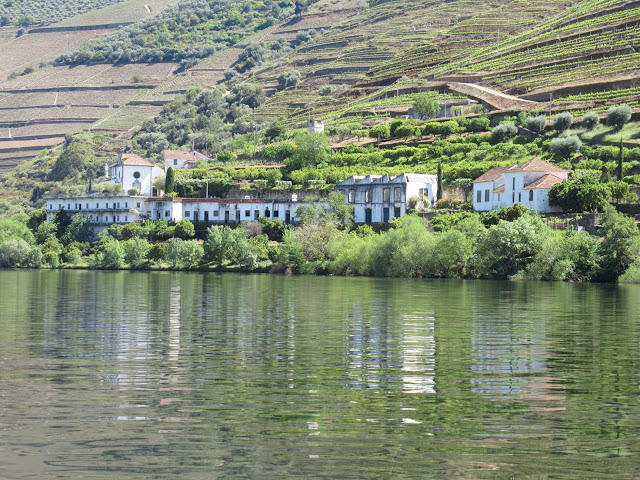Thanks to a recommendation from SYK Backpacks and Flipflops our first stop in the Douro Valley is at this lovely family winery Quinta de Marrocos in Peso da Regua.
Suffice it to say that we were pampered in every way here and thoroughly enjoyed our stay from the welcome glass of port to the personal tour of the winery, to a fabulous dinner and port tasting. We were told to wander the house and grounds as if it were our home and two dogs were just as eager to make us feel at home. The antiques and decor throughout the home spoke of the family's gratitude to the past; their passion for making fine port and their commitment to future generations of port and winemakers.
We made the most of the lovely patio in full sun and stunning views:
In the hillside photos on the top row (above) you can see lines of trees. The farmers plant olive trees to mark the boundaries of their land. As an appetizer, we enjoyed the Marrocos olives well-aged in garlic and other seasonings. I'm stretched out enjoying a glass of wine. The train comes up the valley a few times a day and river cruise boats are coming to small villages of the Douro in greater numbers and frequency all the time.
The photos above give a small glimpse of the villa structure and the decor. This winery started out in the 17th. century as a Franciscan monastery, but now is one of the oldest estates in the Douro and has produced award-winning wine and port over four generations. Ourselves and one other couple are served a multi-course meal, each serving more delicious than the last. Then the port tasting.
These words are with us now forever - the four types of port:
The dogs can hardly wait to show us the vineyards:
These terraces (a UNESCO World Heritage) are at a 30%+ gradient. I can hardly manage them on my own, while male workers carry baskets heavily laden with ripe grapes down to a lower level. So much that you see here is made of schist, a slate-like rock: the house, the dry stone walls that define the terraces, the stairs, the support posts for the vines. The schist is integral to the soil and the nutrition of the vines. The narrow paths between the rows of vines are for the women to walk while snipping the grapes at harvest time. The two cypress trees are each 400 years old, planted by the Franciscans at the start of the monastery.
Most of the business of the winery is hidden from view in a rock storage room under one of the buildings.
The barrels above are over 100 years old. The tank lined in red is where the grapes are crushed with feet. This avoids breaking open the seeds which would change the character of the final product. We are invited to return in September to see if we can crush grapes for 3 hours at a time. The cement tanks on the right photo are used to store the must (freshly crushed grapes, juice, seeds, skins and stems).
Everything here is done by hand, as it has been done for two thousand years.
The grape presses top left are not used (only feet). Each cork is put into place with a rubber mallet, each label applied by hand and for the 20, 30 and 40-year-old ports, a wax seal is also applied by hand.
After a satisfying breakfast and heartfelt goodbyes, it's into town to catch the train to Pinhao (the geographical centre of the Douro) where we will spend 2 nights.
The history of Pinhao is told in the azulejo tiles on the outside of the station. The friezes above are just a few in the story.
Senora Maria welcomes us into her home which is 2+ km straight up from town. She has no English words but recognizes our few Spanish words. She is a traditional Portuguese avo (grandmother) and takes care of our every need. She is more than generous adding to our dinner meal in her kitchen and supplying a traditional breakfast each day. Our bedroom has a balcony with a view of the Douro:
Walking down into town from Senora Maria's home are these little stone dwellings:
The calm, sunny day is perfect for a 2-hour Rabelo ride on the Douro. The landscaping, terraces, Quintas and geometrical designs of the planting are breath-taking from the water.
The men in the bottom left photo above are making a dry stack slate wall. Trees could be olive or almond. The bridge is one of a few ancient Roman ones on the Douro.
Random Photos from Pinhao and the boat ride on the Douro:
The tile portrait above reminds me of some of the clothing worn by First Nations peoples in British Columbia.
Pinhao is a peaceful little village with friendly locals. It took us a bit to get used to local customs. Nothing opens early; restaurants close about 2 pm and don't open again until 7 pm. Maria gifts Paul with a bottle of port on our departure.
Random Photos from Pinhao:
 |
| Ponta Romana |
 |
| Concrete storage for the wineries - about a dozen on the waterfront |
 |
| Restored Renault |
We're back in Porto out by the airport in Maia so that we can fly to Bilbao, Spain. The host (Mike) of Coffee Cream Guesthouse is incredible. He made us warm ham and cheese sandwiches, followed by cookies on our arrival. His kitchen is well stocked with all kinds of food, help yourself and we drink wine with him in the evening.
We enjoyed everything about Portugal and realize there are so many places that we didn't have time to see with this quick month-long visit. For starters, there's the Azores; Madeira, Aveiro (the Venice of Portugal), Sintra and .....


































































































